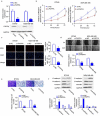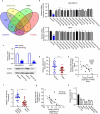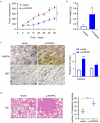Pregnancy-associated plasma protein-A (PAPPA) promotes breast cancer progression
- PMID: 34974815
- PMCID: PMC8805841
- DOI: 10.1080/21655979.2021.2000724
Pregnancy-associated plasma protein-A (PAPPA) promotes breast cancer progression
Abstract
Breast cancer is the most common malignancy in females and poses a significant health threat to women. Pregnancy-associated plasma protein-A (PAPPA) is highly expressed in pregnancy-associated breast cancer (PABC) tissues. In this study, we investigated the functional role of PAPPA in regulating the malignant phenotype of breast cancer. We first examined the expression level of PAPPA in PABC tissue and breast cancer cell lines using quantitative real-time polymerase-chain reaction (qRT-PCR) and western blot. Next, the functional role of PAPPA in breast cancer cells was validated by overexpression and knockdown experiments. Cell counting kit-8 (CCK-8) proliferation assay, 5-ethynyl-2'-deoxyuridine (EdU) incorporation assay, wound healing and transwell invasion assay were used to examine cell proliferation, migration, and invasion ability. We further identified the microRNA target regulating PAPPA and studied its functional role. Finally, we examined the impact of PAPPA on the tumorigenesis and metastasis of breast cancer in mice model. Our study revealed that PAPPA was upregulated in PABC tissues and breast cancer cells. Overexpression of PAPPA promoted cell proliferation, motility, invasion, and epithelial-mesenchymal transition (EMT). We further identified miR-497-5p as a negative regulator of PAPPA, which suppressed cell proliferation, migration, invasion, and EMT in breast cancer cells. We also validated the oncogenic role of PAPPA in the mouse xenograft model. Collectively, our study suggests that PAPPA is an oncogenic protein highly expressed in PABC tissues and promotes breast cancer progression, which could serve as a novel therapeutic target for breast cancer.
Keywords: MCF7; MDA-MB-231; PABC; PAPPA; miR-497-5p.
Conflict of interest statement
The authors declare no competing interests.
Figures







Similar articles
-
Long non-coding RNA MIAT/miR-148b/PAPPA axis modifies cell proliferation and migration in ox-LDL-induced human aorta vascular smooth muscle cells.Life Sci. 2020 Sep 1;256:117852. doi: 10.1016/j.lfs.2020.117852. Epub 2020 May 27. Life Sci. 2020. PMID: 32470448
-
miR-381 inhibited breast cancer cells proliferation, epithelial-to-mesenchymal transition and metastasis by targeting CXCR4.Biomed Pharmacother. 2017 Feb;86:426-433. doi: 10.1016/j.biopha.2016.12.051. Epub 2016 Dec 21. Biomed Pharmacother. 2017. PMID: 28012397
-
MiR-98-5p regulates proliferation and metastasis of MCF-7 breast cancer cells by targeting Gab2.Eur Rev Med Pharmacol Sci. 2019 Apr;23(7):2847-2855. doi: 10.26355/eurrev_201904_17562. Eur Rev Med Pharmacol Sci. 2019. Retraction in: Eur Rev Med Pharmacol Sci. 2020 Nov;24(21):10914. doi: 10.26355/eurrev_202011_23546. PMID: 31002135 Retracted.
-
MDIG in Breast Cancer Progression and Metastasis.Adv Exp Med Biol. 2024;1465:1-14. doi: 10.1007/978-3-031-66686-5_1. Adv Exp Med Biol. 2024. PMID: 39586990 Review.
-
Updates in the pathology of Pregnancy Associated Breast Cancer (PABC).Pathol Res Pract. 2023 Apr;244:154413. doi: 10.1016/j.prp.2023.154413. Epub 2023 Mar 11. Pathol Res Pract. 2023. PMID: 36921545 Review.
Cited by
-
The role of breastfeeding in breast cancer prevention: a literature review.Front Oncol. 2023 Sep 7;13:1257804. doi: 10.3389/fonc.2023.1257804. eCollection 2023. Front Oncol. 2023. PMID: 37746260 Free PMC article. Review.
-
Development and validation of an intratumoral-peritumoral deep transfer learning fusion model for differentiating BI-RADS 3-4 breast nodules.Gland Surg. 2025 Apr 30;14(4):658-669. doi: 10.21037/gs-24-457. Epub 2025 Apr 25. Gland Surg. 2025. PMID: 40405945 Free PMC article.
-
Clinical significance of androgen receptor in unilateral invasive breast cancer in women.Eur J Med Res. 2025 Aug 23;30(1):793. doi: 10.1186/s40001-025-03072-7. Eur J Med Res. 2025. PMID: 40846987 Free PMC article.
-
Circle RNA circ_0007331 promotes colorectal carcinoma by targeting miR-205-5p/high-mobility group A2 axis.Bioengineered. 2022 Apr;13(4):9312-9321. doi: 10.1080/21655979.2022.2051857. Bioengineered. 2022. PMID: 35400282 Free PMC article.
-
PDE3A Is a Highly Expressed Therapy Target in Myxoid Liposarcoma.Cancers (Basel). 2023 Nov 7;15(22):5308. doi: 10.3390/cancers15225308. Cancers (Basel). 2023. PMID: 38001568 Free PMC article.
References
-
- Veronesi U, Boyle P, Goldhirsch A, et al. Breast cancer. Lancet. 2005;365(9472):1727–1741. - PubMed
-
- DeSantis C, Siegel R, Bandi P, et al. Breast cancer statistics, 2011. CA Cancer J Clin. 2011;61(6):409–418. - PubMed
-
- Liang Y, Zhang H, Song X, et al. Metastatic heterogeneity of breast cancer: molecular mechanism and potential therapeutic targets. Semin Cancer Biol. 2020;60:14–27. - PubMed
-
- Peairs KS, Choi Y, Stewart RW, et al. Screening for breast cancer. Semin Oncol. 2017;44(1):60–72. - PubMed
-
- Braden AM, Stankowski RV, Engel JM, et al. Breast cancer biomarkers: risk assessment, diagnosis, prognosis, prediction of treatment efficacy and toxicity, and recurrence. Curr Pharm Des. 2014;20(30):4879–4898. - PubMed
MeSH terms
Substances
LinkOut - more resources
Full Text Sources
Medical
Miscellaneous
